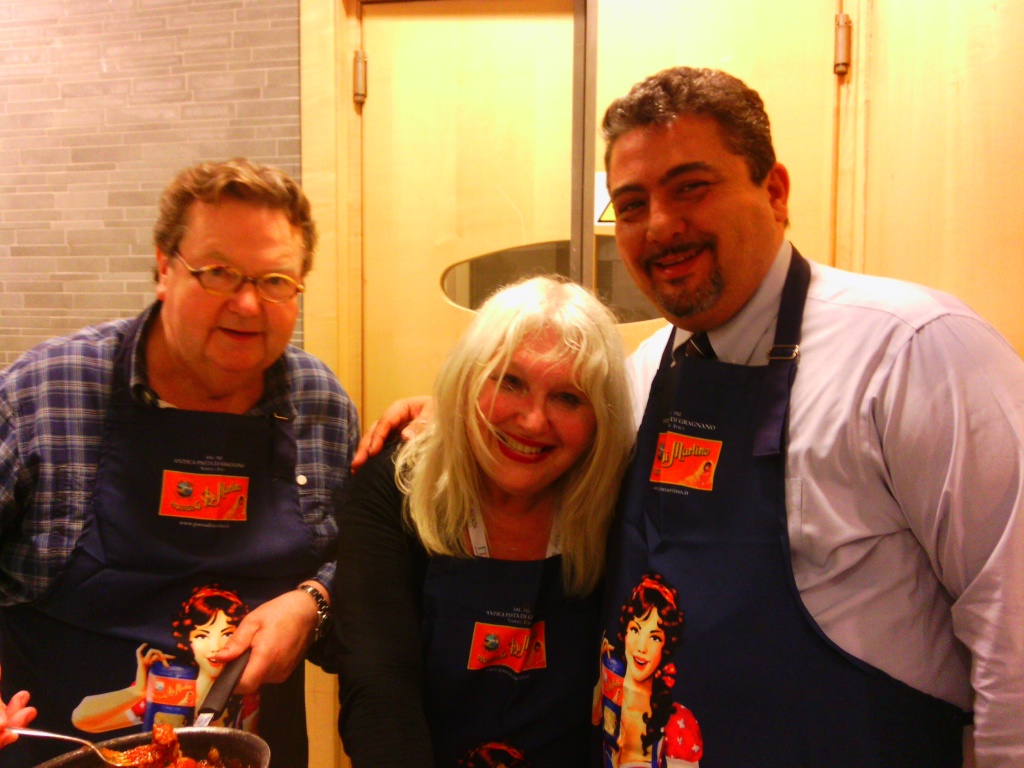They are so cute, aren’t they: food writer (legendary) Gareth Jones and pasta-maker (legendary) Giuseppe Di Martino! And there I am, happily sandwiched inbetween these cute guys, aprons tied on, all of us cooking pasta!
We were at La Citta del Gusto Napoli, a Neapolitan culinary centre for teaching and partying. Giuseppe was our host, the guy throwing the party. Gareth is esteemed British food writer extraordinaire, who can be found these days, more often than not, in Italy, sniffing out stories of deliciousness.
Giuseppe is the third generation of the illustrious Di Martino family, one of the oldest and most famous pasta-making families in Gragnano. He is president of the consortium Gragnano Citta della Pasta and owns Pastifico Di Martino and Pastificio dei Campi as well as Pastificio Antonio Amato in Salerno. He travels the world spreading the goodness of fabulous pasta, and has been a strong motivator in Pasta di Gragnano recieving the prestigious P.G.I mark of excellence and terroir.
No one knows more about pasta than Giuseppe. I say this enthusiastically having eaten pasta with him on so many occasions, over the past decade. These days, is the President of the Gragnano Pasta Makers Consortium; pasta di Gragnano has become a DOP product of internationally known excellence in large part to sheer ebulliunce and devotion to the subject. He travels the world as a goodwill ambassador for his family pasta. Just seeing his smile is enough to make you think: is this (happiness) what pasta can do for me?
Our teacher in this pasta-making extravaganza, besides Giuseppe, was Michelin star Chef Raffaele Vitale, of the Michellin-starred Ristorante Casadelnonno, and his crew. Vitale works in Salerno to promote the cuisine of Campania region.
Our theme for the pasta-licious evening was tomatoes, because 1. we were in Napoli! and in Napoli, when you talk pasta, its ALWAYS about tomatoes. 2. it was the annual tomato harvest and canning. Canning tomatoes is a long held tradition in Campania. When the tomatoes are ripe, of course, fresh tomatoes are everywhere; but when they are not perfectly ripe and in season, no one turns their noses up about canned. That tin, those tomatoes: fabuloso! Of course, they are not just ordinary tomatoes: being rich and sweet and flavourful, preserved with a canning technique that gives care and attention to every detail: the canned/tinned tomatoes of Campania truly are so delicious you can just open a tin, dig in with your fork, and feel goooooood!
Gragnano–where the pasta is made, not far from where our cooking party was being held– is a tiny town slightly inland from the Sorrento Coast whose history of pasta-making is so ancient that the name itself: Gragnano, means grains. Pasta-making in Gragnano dates back at least 2,000 years, so when people start talking about Marco Polo bringing it back from China, Giuseppe just chuckles. “It was a local invention”, dating back to 3 B.C.E, when the local grain harvest needed to be preserved. As hard wheat grew well in the area, unlike the softer wheat (much like the noodles of China) that grew north of Rome. This grain was piled high after harvest for the winter but became infested with insects. It was discovered that by milling the wheat the insects were killed; then the powdery substance was mixed with a little water and spread out to dry. Lagane, the forerunner of lasagne, was the first shape, next came Macari, which we know as macaroni.
Epicious wrote about pasta and gave recipes: not recipes for gourmets and parties, but rather, for feeding the Roman Army, how to build the strength of the Roman soldiers. Gragnano became famous for the excellence of its pasta: the soil that grew the best durun (high protein, high gluten) wheat, and the breezes that blew through the little town drying the sheets of pasta hanging in the piazza.
The menu for our cooking show, class, and party was: 1. bucatini pizzaiola style of cherry tomatoes and a lovely slice of veal which gave the tomatoes the umami of, say, a Japanese sauce with a chunk of seaweed or bonito 2. mezzi canneroni lisci with peels tomatoes and basil, and the dish of celebration 3. ziti with Neapolitan ragu! Because we didn’t have time for the long simmering of a Neapolitan ragu, someone brought in a large potfull, saying that his own nonna, or grandmother, had made it for us! The excitement of everyone in the room, upon seeing and smelling, that gorgeous ragu, was….palpable! what a happy frisson went through the room as Chef Vitale went about cooking the pasta, and serving it up, “just so” and with such loving attention.


















 With over 70 cookbook titles (including contributions) to her credit, Marlena conjures up flavours and dishes from the Mediterranean to Mexico, California to France to the Italian islands and single subjects such as chili peppers, olive oil, mushrooms, to a book on classic Jewish food from all over the world.
With over 70 cookbook titles (including contributions) to her credit, Marlena conjures up flavours and dishes from the Mediterranean to Mexico, California to France to the Italian islands and single subjects such as chili peppers, olive oil, mushrooms, to a book on classic Jewish food from all over the world.
Recent Comments